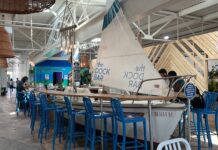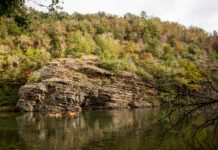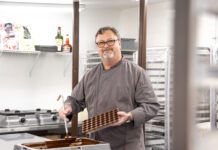With every album he’s released in his short music career, Eric Church climbs higher in adoration. Already loved among his fan base (called the Church Choir), this bad boy of country’s recent Grammy Award nomination for his album Chief indicates that the music world has fallen for him, too. Chesapeake Energy Arena opens its doors to the Nashville star and his Blood, Sweat & Beers Tour on March 8. Considering the arena has been the stage to mega stars such as Lady Gaga, the Rolling Stones and the Dixie Chicks not to mention NBA’s Oklahoma City Thunder it may be a little odd that Church’s first headlining tour would book a venue most musicians aspire to for years or even decades. We’re betting Church fans near and far will easily pack the arena. Now that’s a lot of love. www.chesapeakearena.com
The Servant
Sister M. Therese Gottschalk joined the Sisters of the Sorrowful Mother in 1952 while living in her native Germany. In 1953, she came to the United States and studied pharmacology and later hospital administration. Sister Therese has previously served as president and CEO of St. John Health System. She is now president of Marian Health System, a system of health care facilities that includes St. John, as well as hospitals in Kansas, Wisconsin and Minnesota. Sister Therese heralds the mission of St. John, which is to serve the sick and the poor.
Before I entered our community, I was in an accident and ended up at the hospital for a number of weeks with broken bones. It was a Catholic hospital, and that hospital had sisters. I observed the sisters, and I got the idea that I would like to do the work they do, so I decided to enter our congregation. After a few weeks they asked me what kind of career I wanted to have, and I told them I wanted to be a nurse. But they needed pharmacists, and so they asked me to be a pharmacist.
After my training, I was a pharmacist for eight years at a hospital in Roswell, New Mexico. It was at that point that I (was asked) to go into hospital administration. I have always held the belief that whatever I was asked to do, I would get the courage to do. And I was never asked to do anything I was not educated or prepared to do.
As soon as I finished my residency in hospital administration, I was asked to come to St. John, and I was here as vice president for two years, before moving back to Roswell for two years. Then I came back to Tulsa in 1974, nearly 40 years ago.
When I was here for the first two years as vice president, we were designing a new hospital, and to my surprise when I came back two years later (in 1974), they hadn’t started construction yet because it was such a big project that the architect needed two years to design it.
We needed the new hospital very badly. The majority of our patient rooms had no running water, no toilets, no air conditioning; the original structure was built in the 1920s. We couldn’t remodel because the hospital was so small. Technology had changed everything.
I have a strong belief that health care is a right. It’s not just the poor or indigent we take care of, but it’s all the working people. A lot of companies in Tulsa don’t provide health insurance. People get sick. They don’t make enough to afford treatment themselves, and so, what would they do? It’s not their fault that they don’t have health insurance. It’s the system. We need health care for all people. I hope that St. John will continue to provide health care for all those in need. Whatever people need, we should provide for them.
The Eagles Have Landed
The bald eagles of eastern Oklahoma’s Sequoyah National Wildlife Refuge hatched baby eagles right on schedule this year, just as they did in 2011.
Of course, you already know that, if you are one of the 150 or so people who participated in the refuge’s annual Eagle Watch Tour, or you have watched the eagles’ exploits on the live “eagle cam” feed.
Sequoyah National Wildlife Refuge is a great destination even without eagles. Just south of I-40 about 30 miles shy of the Arkansas border, the refuge features everything from bobcats to coots to snow geese. But during nesting season, bald eagles are the main attraction.
“There are many things to see, but everyone wants to see nesting eagles,” says Leann Bunn, a naturalist at nearby Tenkiller Lake. “There’s just something about that majestic bird and seeing them on the nest.”
With its distinctive white head and tail, hooked beak and what appears to be a fierce, penetrating gaze, a bald eagle is indeed a sight to behold. One can do exactly that on the refuge’s annual Eagle Watch Tour. Since 2001, the Sequoyah refuge has offered the tour on seven consecutive Saturdays in January through March.
The tour begins at refuge headquarters, where visitors watch the eagle cam feed on a 64-inch display. It is a remarkable sight: an eagle pair building their nest, incubating the eggs, eggs hatching and parents feeding their chicks.
The eagle cam can also be viewed online and receives more than 4 million hits a year. Those who have watched this season’s reality show unfold saw three eagle eggs laid and hatched. The live feed (at www.suttoncenter.org) will continue until the eaglets “fledge” sometime in mid- to late-April.
As tour visitors watch the eagle cam, Ford and Bunn provide color commentary. Then the group loads up on the tour bus to view the eagles in their habitat. From a distance of 250 yards, visitors are able to watch the eagles through binoculars and spotting scopes.
Although bald eagles were once present in abundance all over our country, by the mid-20th century the species was nearly gone. No bald eagles were sighted in Oklahoma for several decades.
“That’s right,” says Bunn. “We almost didn’t have any bald eagles left in Oklahoma.”
Thanks to the Bald Eagle Protection Act (1940), the Endangered Species Act (1973) and the work of organizations such as the Sutton Avian Research Center near Bartlesville, bald eagles are thriving again in Oklahoma.
“The number of nesting bald eagle pairs in the state of Oklahoma was 70 to 75 in 2009. That number was up to about 100 last year,” says Chad Ford, visitor services specialist for Sequoyah National Wildlife Refuge.
The 2012 Eagle Watch Tour is over now. However, Ford was quick to say, “Tell everyone to be ready for next year.” The tour begins again on Jan. 19, 2013, and continues for six successive Saturdays. Tours are free and no registration is required. Just show up at the refuge headquarters at 9 a.m.
“I’d love to see more people coming for the tour,” Ford says.
Sooner "Sisters"
When you think of the Tulsa suburb of Bixby, do you instinctively think of exotic Waikiki? Do you know about Pawhuska’s 183-year-old connection to a village in southern France? Are you aware of Shawnee’s kinship with a small town in northern Japan?
Sister city programs usually seek to promote economic development, tourism and education. Leave it to Oklahoma to add a unique Native American twist to the concept.
Many Oklahoma cities have hooked up with sister cities around the world. Tulsa has eight sister cities; Oklahoma City, six. Many smaller cities and towns also enjoy sister city ties, including Bixby (Waikiki, Hawaii), Claremore (Salekhard, Russia), Lawton (Güllesheim, Germany), Norman (cities in France, Mexico and Japan), Ponca City (Baiyin, China), Stillwater (Kameoka, Japan) and Yukon (Krnov, Czech Republic).
Two of the most interesting alliances are Pawhuska’s historic relationship with a village in France and Shawnee’s close tie to a town in Japan. In both cases, part of what makes the connection special is satisfying the fascination other nations have with Native American history and culture.
Pawkuska, about an hour northwest of Tulsa, is not only the seat of Osage County, but also capital of the Osage Nation. The area’s tie to France dates back to the 1700s, when King Louis XIV staked France’s claim on “Louisiana,” a sprawling territory that included modern-day Oklahoma. From 1827 to 1829, a group of Osage Indians journeyed to France and had a dramatic sojourn in a small town called Montauban.
Flash forward more than 150 years. In 1987, Montauban citizens, inspired by the story of the historic Osage visitors, struck up a sister city relationship with Pawhuska. During the 24 years since, many representatives of both Pawhuska and the Osage Tribe have made the journey to Montauban, and have welcomed frequent visitors from France.
“Those Europeans really like Native American culture,” says Pawhuska Chamber director Mike McCartney. The relationship has paved the way for visitors from other European communities as well, McCartney says. “A lot of times they come over to greet some of the families that have hosted them before, and we don’t even know that they are here.”
Shawnee, population 30,000, has a sister city tie with Nikaho, Japan, population 27,000. The connection began when TDK Corp. built a plant in Shawnee. Tim Burg, Shawnee’s economic development director, says the plant employs approximately 150 people.
“That relationship between our community and the sister city in Japan is vital and critical to the operation here,” Burg says.
So, to promote and preserve good will, Shawnee proposed a sister city connection with Nikaho, location of the first TDK plant. Burg says the program gives Shawnee an “international flair” and has helped lure other companies, including five manufacturers that are internationally owned.
Japanese interest in the program is about more than economic development. “The Japanese have a great interest in Native American culture,” Burg adds, pointing out that Shawnee is headquarters of the Citizen Potawatomi tribe.
Ready For Tomorrow
Oklahomans old enough to remember the arrival of cable television in the state probably recall the clunky nature of the system. The centerpiece, a small box attached to the television with one lever to move horizontally to numbered channels, came with a warning: Don’t move the lever too fast to change channels. Whether this was really something to worry about or just parents’ means to limit the “click, click” of channel-changing children, one might never know.
But other changes in the cable industry? It would be hard to find an adult in Oklahoma – even one who still favors rabbit ears – who isn’t well aware of those. And what is the prognosis for changes to how households receive entertainment programming in the future?
“It used to be that you’d order a piece of equipment, but by the time you get it and go to install it, there was a better product already,” says Percy Kirk, senior vice president and general manager for Cox Communications in Oklahoma. “Today, (change) is even faster. Much, much faster.”
While many changes are being embraced by the cable industry, such as High Definition programming and digital video recording, to name just two, other changes are originating from brand new competition. With service such as Netflix and Hulu, with Apple’s early first steps into entertainment program delivery and numerous other advances, it’s little wonder that some feel the era of cable television is coming to an end.
But skeptics might not want to rush to plan a cable funeral. If Cox Communications – the third largest cable company in the US serving six million homes and businesses – is an example, then smarter cable providers are well prepared to adapt to changes in the market.
“The evolution now includes the convergence of our products and services.”
“We’re not only adapting to this change in the marketplace, we’re embracing change head-on,” says Cox vice president of Government and Public Affairs Kristin Peck. “This is a very capital-intensive business and we are making the necessary investments in our network platform – more than a billion dollars over the last several years in Oklahoma alone – to ensure delivery of the products and services consumers are asking for.”
It is Cox’s vaunted network platform that has enabled the company to adapt to changes in the marketplace and to expand its scope of services exponentially in recent years, while competitors elsewhere fell behind, Kirk says.
“When we first got started in Oklahoma, we ended up building a very robust platform,” Kirk says.
That communications infrastructure enabled Cox to embrace and blaze a trail in the industry and become an early embracer of major developments such as digital cable and high definition programming. Today, Cox offers an array of advanced digital video, high-speed Internet and telephony services over its own nationwide IP network, as well as integrated wireless services. Commercial voice, video and data services are offered via Cox Business.
“We’ve evolved from merely a video service 30 years ago, to a robust platform of telecommunications services,” Peck says. “The evolution now includes the convergence of our products and services. Cox TV Connect, allowing you to view TV shows through your iPad, is a good example of this.”
That integration of technology is key to the enthusiasm with which Cox considers further advancement.
“If you’re a programmer, say HBO, you want to maximize the exposure of your content,” Kirk says. That content has historically been delivered through platforms like cable and satellite television. Today, through services like Hulu, a programmer can reach the market more directly.
“In my view I think we’ll find that we provide value in different things that will benefit many consumers,” Kirk says. “Other consumers will choose to get content directly and they won’t care that the material is dated or limited.”
Kirk feels the not-too-distant household will look a little different than those today.
“I think we may end up with a device in the home, perhaps provided by someone like us, that has multiple inputs,” he says.
The device would allow access to television, video, music, telephone and conceivably numerous types of potential smart house apps, etc. Just as Yahoo and Google provide a framework to access and structure the infinite nature of the internet, service providers such as Cox will conceivably frame the massive volume of material for easy access and interaction with tomorrow’s consumers.
“The benefit is also that the consumer would be able to do some very different things,” Kirk says. “Say you’re watching a Thunder game and they’re playing the Lakers. You want to know how they have traditionally done versus the Lakers, so you can pull up the data. Or if you want to know how many points Kevin Durant scored against LA the last time they played. Part of the beauty of our network is that it is very robust and has a very strong two-way connection.
“Consumers will have the ability to get what the want, but there has got to be a way to make it easier for them to do that.”
Cox also addresses changes to the industry proactively. A company strategy group and technology group provide a lot of forward looking at Cox, and the company has historically anticipated customer demand.
“We work with technology companies, entertainment companies and talk with Silicon Valley people so that we can figure out where things are headed and what’s important to consumers,” Kirk says.
Kirk is among Cox executives excited about the future of the industry.
“When you look at the future, because of the nature of our platform, we are able to do so much, the reality is that I don’t know of anyone better positioned to deliver great product to our customers,” he says. “No one is more excited than me. We have come a long way from the 35 channels we had when we started in Oklahoma.”
Have Songs, Will Travel
Seems that Alison Krauss has fronted Union Station for a long time. In fact, she was a teenager when she recorded the album Too Late to Cry and released it in 1987 with the band Union Station. After more than two decades, contemporary bluegrass has never sounded more mature and intense.
Alison Krauss & Union Station are touring following the April release of their latest album, Paper Airplane – her first album of all-new recordings with the band since 2004, and a poignant, prairie-tinged follow up to 2007’s Raising Sand, her blockbuster collaboration with rock music’s Robert Plant.
Just as they did throughout the 1990s and 2000s, Krauss and the band still draw new fans to fiddle music and America’s roots sound in country and folk. Paper Airplane quickly rose on the music charts and earned Krauss two more Grammy Awards last month, making her the most decorated living artists in Grammy history. Alison Krauss & Union Station are no strangers to acclaim.
Add to this impeccably well-tailored outfit of Krauss, Jerry Douglas, Dan Tyminski, Ron Block and Barry Bales a studio production legend like Mike Shipley, and you have a collection of songs lovingly crafted and performed to the fascination of Krauss & Union Station fans, which are plentiful in a music-loving town like Tulsa. Krauss and the band are booked to play Brady Theater on March 24. There’s little rest for this band – the next evening, March 25, the group hops over to Oklahoma City and its OKC Civic Center Music Hall. Everyone can get on board with that. For more, go online at www.bradytheater.com and to www.okcciviccenter.com for details on both shows.






















